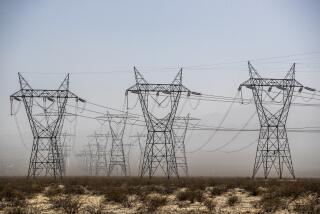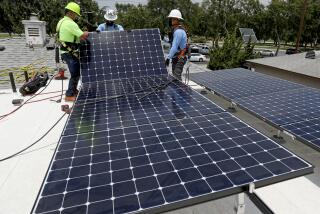Has blazing a trail in solar energy cost California too much?
That ray of light you see peeking through all the clouds darkening California’s future? That’s the sun. More specifically, solar power, in which California is the hands-down national leader.
The state’s installed solar generating capacity of about 1.2 gigawatts — the equivalent of two big conventional power plants and enough to fill the electrical demand from nearly 200,000 homes for a year — easily outstrips the next 10 highest-ranked states. It’s also the fastest-growing solar market in the country.
So you may not be surprised to learn that California’s big utilities are fighting like mad to keep a lid on that growth. The most important battle in that war is scheduled for this week, with California’s continued primacy as a solar state hanging in the balance. More than bragging rights are at stake: California’s solar industry has created 26,000 jobs, or 1 in 4 solar jobs nationwide, according to a recent study by the UC Berkeley law school. And California’s solar generation will have to keep growing if the state is to meet Gov. Jerry Brown’s goal of generating 12 gigawatts from clean sources such as solar, wind and fuel cells by 2020.
But one nagging question underlies the state’s success thus far: Have we spent too much to get here?
The question is raised by a battle over a practice known as net metering, which was established by a 1995 state law and went into effect a few years later. Think of it as the basis for your solar salesman’s claim that you can cut your electric bill big time by mounting solar panels on your roof.
Simply put, via net metering you get credit for the electricity your rooftop generates when your overall usage is low, say when you’re at work during the day, and you apply it to the bill for the power you use at night, when you’re home and the sun isn’t shining. You’re netting your rooftop generation against your nighttime usage and emerging with a lower bill.
The solar industry and renewable energy advocates say that although other incentive programs have been created by California and the federal government to encourage the spread of renewable energy, net metering is the most important driver of the explosive growth in residential solar. “That’s the foundation of the solar industry in California,” says Dan Sullivan, president of Sullivan Solar Power in San Diego, which expects to install $22 million worth of residential and industrial solar generating units this year. Indeed, net metering has been so successful in California that 42 other states have enacted similar rules.
To solar advocates, net metering has two chief virtues: It’s simple to understand, and it’s predictable. Utilities are required to credit homeowners for their excess rooftop generation — that’s the electricity they don’t use at the time it’s generated — at the highest rate they pay for the electricity they purchase from the utility. In other words, if your solar panels reduce your utility consumption to a rate tier pegged at 14 cents per kilowatt-hour, the utility has to credit you 14 cents per kilowatt-hour for the solar generation you contribute to the system. Project that out for a decade or so, and you can come up with a reasonable estimate of how long it will take for the savings on your power bill to pay for the installation.
To utilities and ratepayer advocates such as the nonprofit ratepayer advocacy group TURN, however, the credit is too rich. They say net metering rates deliver an unfair subsidy to those homeowners and businesses sufficiently well-heeled to install solar panels, while imposing costs on everybody else.
That brings us to a battle scheduled Thursday before the California Public Utilities Commission.
The particular topic of the PUC vote is how to calculate a cap on net metering eligibility imposed by the Legislature when it authorized the rate. Once residential and other small-scale solar installations reach 5% of “aggregate customer peak demand,” the law says, net metering expires. You won’t be surprised to hear that the utilities have one way of calculating that figure, and the solar installation industry another. The difference amounts to more than 2 gigawatts of solar capacity, equivalent to a doubling of the potential market subject to net metering if the solar people get their way.
Solar advocates say that the utilities’ math would mean an end to new net metering installations starting as soon as late 2013. The solar industry’s more liberal calculation could give it breathing space of another couple of years before the cap kicks in.
The most powerful advocate of the solar industry’s position is PUC President Michael Peevey, author of the proposed decision on the commission’s docket. In his proposal, Peevey declares that the more liberal calculation of the cap is plainly what the Legislature intended, and his intention is just to clarify things. He’s seconded by former Assemblyman Fred Keeley, an author of the net metering law, who wrote in a recent op-ed in the Sacramento Bee that by providing the maximum headroom for small-scale solar generation, Peevey’s channeling him and his co-authors: “Take it from me, that was the intent of the law as we wrote it.”
On the other side, the state’s private utilities and TURN argue that today’s net metering rates favor wealthier homeowners with bigger houses and higher power consumption because they get a higher payback per solar-generated kilowatt-hour than those with lower usage and smaller installations. They argue that the rates also discourage conservation because you get a better payback for solar the more electricity you consume. “That’s the opposite incentive from what you should have for solar,” Marcel Hawiger, a staff attorney at TURN, told me.
The real problem is that no one is really sure how much of a subsidy is baked into the rates. A 2009 PUC staff study pegged it at nearly $140 million a year paid by ordinary utility customers to their solar-powered neighbors. But solar advocates say that figure was inflated by the steeply higher rates then paid by heavy power users in Pacific Gas & Electric Co.’s territory. That utility’s rates have flattened out since then.
A more recent study finds net metering to be a “wash” overall, says Berkeley energy consultant R. Thomas Beach, its author. And that’s not counting the gains from jobs, the creation of a new industry and cleaner air. Those factors are hard to quantify for rate-setting, “but there’s a reason there are 43 states with net metering on the books,” Beach says. “For the consumer buying solar, it’s simple and understandable.”
TURN, which is in favor of renewable power sources, says California has avoided a broad debate about the right price to pay for household solar generation for too long. Peevey’s proposal, it says, will keep that from happening by perpetuating an unfair subsidy. The group may be right. California has established itself as a pioneer in creating a solar industry, but it may have done so by throwing money at the problem. As the state moves ahead, it may be time to ask if it can get more for less.
Michael Hiltzik’s column appears Sundays and Wednesdays. Reach him at mhiltzik@latimes.com, read past columns at latimes.com/hiltzik, check out facebook.com/hiltzik and follow @latimeshiltzik on Twitter.







